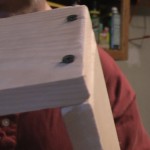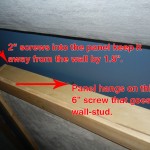 [Click on any picture for higher resolution] For the last couple of weeks I have been writing about how I’ve been building custom acoustic treatment panels for my new project studio which is running SONAR X1 Producer Expanded. I started with the sound cloud over the mix position and then showed how I basically cut out all the corners of my room (a square room unfortunately for me) by building corner traps. This week I’ll dive into probably the most important component; the wall panels.
[Click on any picture for higher resolution] For the last couple of weeks I have been writing about how I’ve been building custom acoustic treatment panels for my new project studio which is running SONAR X1 Producer Expanded. I started with the sound cloud over the mix position and then showed how I basically cut out all the corners of my room (a square room unfortunately for me) by building corner traps. This week I’ll dive into probably the most important component; the wall panels.
 The wall panels are really important for me for a few reasons. (1.) They absorb the first sound reflection from the speakers so that the frequency waves are tamed down, and (2.) They absorb the sound in the room in general to control echo and reverberation. I do a bit of professional moonlighting work on the side including songwriting/production for ESPN Sports Center as well as other commercial stuff, so it’s important for me to have a controlled environment to listen to my mixes and productions on SONAR so that what I deliver is the real-deal. As I stated before, it’s pretty much impossible to create a perfect listening environment unless you are building a room from scratch (floating room, sound proofing inside the walls, etc…,) but it is possible to greatly improve your surroundings. In my own opinion, I think the way to look at it is to figure out what it is you are trying to accomplish before you purchase or build anything. I think some of the important questions to ask are:
The wall panels are really important for me for a few reasons. (1.) They absorb the first sound reflection from the speakers so that the frequency waves are tamed down, and (2.) They absorb the sound in the room in general to control echo and reverberation. I do a bit of professional moonlighting work on the side including songwriting/production for ESPN Sports Center as well as other commercial stuff, so it’s important for me to have a controlled environment to listen to my mixes and productions on SONAR so that what I deliver is the real-deal. As I stated before, it’s pretty much impossible to create a perfect listening environment unless you are building a room from scratch (floating room, sound proofing inside the walls, etc…,) but it is possible to greatly improve your surroundings. In my own opinion, I think the way to look at it is to figure out what it is you are trying to accomplish before you purchase or build anything. I think some of the important questions to ask are:
*How much can I afford to put into the project?
*Is it important for the place to look professional?
*Will a vibed-out room make you or whoever is using the room feel more creative?
*What are the basic sonic trouble elements to the room?
*Will the room be used for mixing or recording?
*What genre of music will the room be used for (i.e.> Hip-hop with a lot of low end, Jazz, etc…)
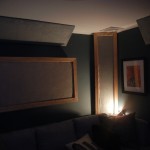 In my case, *I wanted to keep my costs as low as possible; *I wanted to room to look as professional as possible; *I wanted a great vibe to the room; *I have a 13.5’ x 13.5’ room with low ceilings which creates a lot of bass problems; *and I will be using the room for mixing and primarily recording vocals in many different genres. Taking all this into consideration I came up with a game plan to build my own acoustic treatment for the room.
In my case, *I wanted to keep my costs as low as possible; *I wanted to room to look as professional as possible; *I wanted a great vibe to the room; *I have a 13.5’ x 13.5’ room with low ceilings which creates a lot of bass problems; *and I will be using the room for mixing and primarily recording vocals in many different genres. Taking all this into consideration I came up with a game plan to build my own acoustic treatment for the room.
Before I go into any detail, I need to state that I am not a professional carpenter, and these are not direct instructions on “how to” build acoustic panels. I am simply showing you how I built mine, and if you care to attempt to build your own, you are responsible for how you use this information to build and install these panels on your own and AT YOUR OWN RISK. The bottom line is that neither Cakewalk nor I are in any way responsible for how you use this information. I’m not claiming in any way to be an expert on this matter. I simply did some research, talked to a lot of trusted friends, and then went for it. Also, I did use some basic power tools as well as hand tools that I will recommend, so if you are uncomfortable using tools please seek help from a professional.
How I build the wall panels:
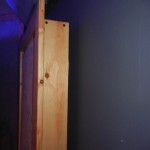 For my room I measured the walls and decided that I would place seven (7) 4’ x 2’ x 4” panels strategically hanging around the perimeter. From the research I did and also talking to friends of mine such as Gavin Haverstick of Haverstick Designs and Carl Nappa who know way more than I do about this stuff, I decided that these panels would not go flush against the wall but rather would sit 1.5” away from the wall. This creates an air gap that allows the panel to absorb sound from both sides which in turn creates greater sound absorption. Later on in this article I will explain how I accomplished this feature. I also decided to use an 8th panel on the floor resting between my speakers.
For my room I measured the walls and decided that I would place seven (7) 4’ x 2’ x 4” panels strategically hanging around the perimeter. From the research I did and also talking to friends of mine such as Gavin Haverstick of Haverstick Designs and Carl Nappa who know way more than I do about this stuff, I decided that these panels would not go flush against the wall but rather would sit 1.5” away from the wall. This creates an air gap that allows the panel to absorb sound from both sides which in turn creates greater sound absorption. Later on in this article I will explain how I accomplished this feature. I also decided to use an 8th panel on the floor resting between my speakers.
After pricing out the insulation, I decided to go with a mix of Owens Corning 703 (I actually used Knauf which is the same specs just more organic) and Rockwool sheets both being 4’ x 2’ x 4” (I had to double up the Knauf as it came in 2” thick sheets.) From what I understand they are very similar in nature but the Knauf and OC703 are more expensive.
*The exact materials I used for making and installing one wall panel were (estimated costs since I used these materials for multiple panels):
– Roxul 4″ thick Mineral Wool 4′ x 2′ sheet, Cost: $13.50
– (2.2) 8’ x 3” x ¾” Furring strips (wood) from Home Depot, Cost: $2.25 (for the exterior frame)
– (2) 6’ x 4” x 3/4” Pine, Cost: $10.13 (for the box-frame)
– Fabric – CASTIELLE ACOUSTIC SUEDE (key;-) FABRIC BY THE YARD, Cost: $5.96 (1 panel)
– Wrapping for back of panel- Home Depot paper-throw tarp, Cost: $1:39 (1 panel)
– Screws for assembling the box and frame, Cost: $.72
– Screws for mounting the panels to the wall, Cost: $.04
– 3/8ths Staples, Cost: $.25
– Polyurethane/Stain, Cost: $.82
*Tools Used:
– Sand paper ( I used a motorized sander which was easier)
– Electric Power Miter Saw (you can very easily achieve the same cuts with a hand saw)
– Pro grade staple gun (not electric
– Staples (“T50 3/8th” 10mm Heavy Duty made by Arrow
– All-in-one polyurethane/stain and a brush
– Stud-finder
– Philips head screwdriver (I used a power driver but a regular screwdriver would work fine)
– Knee pads
– Protective rubber work gloves, eye protection, and a breathing mask
BUILD THE BOX-FRAME – MEASURE AND CUT THE WOOD: There are basically two components to the frame on these: The box-frame that houses the insulation, and the external frame that goes over the box to make it look nice. For the box-frame, I first took each 6’ board and cut them down so that there were two (2) 4’ pieces, and two (2) 2’ pieces.
 SAND THE EDGES: Using a power sander (you can easily accomplish the same feat with sandpaper) I sanded down all the edges of each piece and also made sure there were no splintering ends popping up. So now I had 4 sanded pieces of wood with which to work.
SAND THE EDGES: Using a power sander (you can easily accomplish the same feat with sandpaper) I sanded down all the edges of each piece and also made sure there were no splintering ends popping up. So now I had 4 sanded pieces of wood with which to work.
 BUILD THE FRAME BY SCREWING TOGETHER THE PIECES: This can get a bit tricky if you are working alone. The first 2 pieces of wood joining together are the hardest. The ends of a long piece and a short piece are joined together with the short piece on top.
BUILD THE FRAME BY SCREWING TOGETHER THE PIECES: This can get a bit tricky if you are working alone. The first 2 pieces of wood joining together are the hardest. The ends of a long piece and a short piece are joined together with the short piece on top.
Using a table to stabilize the pieces since I am working alone, I lined up the pieces and drove the first screw in so that it went through the top end of the short piece into the end edge of the long piece. I drove the screw in very slowly and carefully to minimize the chance of splitting the wood. The second screw was then driven into the other end of the corner.

Once the two screws were in, I then worked my way around the perimeter of the frame until the box was built. The biggest thing to remember here is to make sure the screws are put in straight, and to try to drive the screws down the middle of the long pieces.
BUILD THE EXTERIOR FRAME – MEASURE AND CUT THE WOOD (FURRING STRIPS): The exterior frame is what makes these panels look professional (in my opinion.) To accomplish this, first I exactly measured the inside perimeter of the box-frame so that I knew how to cut the frame. The exterior frame goes over the box-frame so it overlaps a bit; meaning that the inside perimeter of exterior frame is smaller than the inside perimeter of the box-frame. This helps to keep the insulation in place and also makes it easier to staple in the fabric – it also covers up the box-frame. So with my inside perimeter of the box-frame being 48” x 22.5”, I measured out the furring strips and made my 45 degree angle cuts so that the inside perimeter of the furring strips were 46.5” x 21”. This created an overlapping boarder over the box-frame.
SAND THE EDGES: I then sanded the edges of the furring strips with a power sander so that there were no rough edges to be found.
 ASSEMBLE THE EXTERIOR FRAME: I inspected the wood and identified the best sides. These furring strips are so cheap that you have to check out each piece to make sure they are visually suitable and usually one side is better than the other.
ASSEMBLE THE EXTERIOR FRAME: I inspected the wood and identified the best sides. These furring strips are so cheap that you have to check out each piece to make sure they are visually suitable and usually one side is better than the other.  Next I laid out all 4 pieces on the ground upside down so that the staples that join the pieces are not on the visible side. Starting in one corner, I then began to staple the pieces together until the frame was one rectangular piece.
Next I laid out all 4 pieces on the ground upside down so that the staples that join the pieces are not on the visible side. Starting in one corner, I then began to staple the pieces together until the frame was one rectangular piece.
 ATTACH THE EXTERIOR FRAME TO THE BOX-FRAME: The biggest thing to remember here is that the exterior frame is not very stable until it’s screwed into the box-frame. So knowing this, I carefully lifted the exterior frame in one motion, flipped it over and placed it on top of the box frame. Starting at one of the 2’ ends, I visually lined up the frame so that it was evenly placed on the box-frame.
ATTACH THE EXTERIOR FRAME TO THE BOX-FRAME: The biggest thing to remember here is that the exterior frame is not very stable until it’s screwed into the box-frame. So knowing this, I carefully lifted the exterior frame in one motion, flipped it over and placed it on top of the box frame. Starting at one of the 2’ ends, I visually lined up the frame so that it was evenly placed on the box-frame.  This isn’t too important because you can manipulate how it sits as you start to screw it down. I then took a screw (the same screws as the other step) and in one corner carefully screwed through the top of the exterior frame into the edge of the box-frame.
This isn’t too important because you can manipulate how it sits as you start to screw it down. I then took a screw (the same screws as the other step) and in one corner carefully screwed through the top of the exterior frame into the edge of the box-frame.
 This can be tricky too as you have to be careful that you are aligning the screw so that it hits the edge of the box-frame. Learning from “trial by fire” I can tell you the best way to do this is to move to the opposite corner and align and drive another screw.
This can be tricky too as you have to be careful that you are aligning the screw so that it hits the edge of the box-frame. Learning from “trial by fire” I can tell you the best way to do this is to move to the opposite corner and align and drive another screw.  Continue onto the other end and manipulate the exterior frame so that it lines up straight. Once you have 4 screws in and the exterior frame is straight and aligned properly over the box-frame, continue to drive 4 more screws into the opposite edges and then more screws in the middle of the frame for stability.
Continue onto the other end and manipulate the exterior frame so that it lines up straight. Once you have 4 screws in and the exterior frame is straight and aligned properly over the box-frame, continue to drive 4 more screws into the opposite edges and then more screws in the middle of the frame for stability.
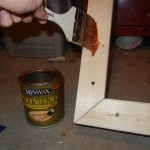 STAIN AND POLYURITHAINE THE FRAME: After the frame was assembled, I used an all-in-one polyurethane/stain to finish the panel. You can also paint the frame, but either way make sure that you allow it to dry so that you don’t ruin the fabric when you go to the next step.
STAIN AND POLYURITHAINE THE FRAME: After the frame was assembled, I used an all-in-one polyurethane/stain to finish the panel. You can also paint the frame, but either way make sure that you allow it to dry so that you don’t ruin the fabric when you go to the next step.
 STAPLE IN THE FABRIC: After the frame dried, I turned the frame upside down and stapled in the fabric. It’s important to note that the fabric is being stapled to the underneath overlay of the exterior-frame. The best way to do this is to start in one corner and work your way down the long side laying in staples about every 5 inches or so.
STAPLE IN THE FABRIC: After the frame dried, I turned the frame upside down and stapled in the fabric. It’s important to note that the fabric is being stapled to the underneath overlay of the exterior-frame. The best way to do this is to start in one corner and work your way down the long side laying in staples about every 5 inches or so.  The corners are the most important thing to consider. Next lay in staples on a short side and continue along the other long side. You have to get a feel for it, but you want to gently pull the fabric as tight as possible without ripping out from the other side.
The corners are the most important thing to consider. Next lay in staples on a short side and continue along the other long side. You have to get a feel for it, but you want to gently pull the fabric as tight as possible without ripping out from the other side.  You want to pull the fabric toward you and away from each last staple you laid in. Leaving one short side unstapled, I then went back between the 5 inch staples on each long side and laid in more staples pulling the fabric tighter. Finally I went to the last short side and laid in staples to pull the fabric as tight as possible. It’s helpful at this point to double check the corners to make sure they are covered and tight.
You want to pull the fabric toward you and away from each last staple you laid in. Leaving one short side unstapled, I then went back between the 5 inch staples on each long side and laid in more staples pulling the fabric tighter. Finally I went to the last short side and laid in staples to pull the fabric as tight as possible. It’s helpful at this point to double check the corners to make sure they are covered and tight.
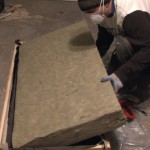 LAY IN THE INSULATION: Wearing protective gloves, a long sleeve shirt and a low-grade breathing mask, I handled the insulation carefully and laid it into the upside-down frame. I then stapled the insulation to the box-frame around the perimeter but didn’t go overboard.
LAY IN THE INSULATION: Wearing protective gloves, a long sleeve shirt and a low-grade breathing mask, I handled the insulation carefully and laid it into the upside-down frame. I then stapled the insulation to the box-frame around the perimeter but didn’t go overboard.
 WRAP AND STAPLE THE BACK OF THE PANEL WITH PAPER/POLY DROP CLOTH: As I stated before, I was going for a “cost effective” approach here with my whole room. One of the ways I saved a good amount of coin was by covering the back of my panels with the above noted cloth opposed to wrapping each panel completely in the acoustic fabric.
WRAP AND STAPLE THE BACK OF THE PANEL WITH PAPER/POLY DROP CLOTH: As I stated before, I was going for a “cost effective” approach here with my whole room. One of the ways I saved a good amount of coin was by covering the back of my panels with the above noted cloth opposed to wrapping each panel completely in the acoustic fabric.  I think wrapping the insulation completely in fabric is much easier and probably a better all-around solution, but in my case I was into trying to save some dough. I achieved this by just sealing the back off with the cloth and staples. I went around the perimeter of the frame over the insulation, and then I folded the cloth back over so that it was double wrapped.
I think wrapping the insulation completely in fabric is much easier and probably a better all-around solution, but in my case I was into trying to save some dough. I achieved this by just sealing the back off with the cloth and staples. I went around the perimeter of the frame over the insulation, and then I folded the cloth back over so that it was double wrapped.
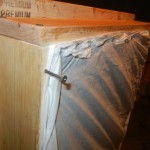 INSTALLING THE PANELS TO THE WALLS: After thinking this through for a while, I came up with a unique and inexpensive way to get these panels up on the walls using 4 short screws and 1 long screw. Since the wood I used was so cheap, it was also very light.
INSTALLING THE PANELS TO THE WALLS: After thinking this through for a while, I came up with a unique and inexpensive way to get these panels up on the walls using 4 short screws and 1 long screw. Since the wood I used was so cheap, it was also very light.
This worked in my favor as the panels are not very heavy at all (although they look hefty.) Using the same screws to assemble the frames, I drove in a screw in the back of each corner so that there was 1.5” from the head to the frame. This created the “air-gap” between the panel and the wall that I was talking about earlier in this article.
 Next, I found the first points of reflection on each wall (see my PART 1 article for how to accomplish this) and determined where to place the first two (left-wall and right-wall) panels. Once I determined this, I then used a stud finder to see if I could utilize a wall stud to drive the holding screw into. On one wall I got lucky and on another I was forced to use a heavy-duty wall anchor.
Next, I found the first points of reflection on each wall (see my PART 1 article for how to accomplish this) and determined where to place the first two (left-wall and right-wall) panels. Once I determined this, I then used a stud finder to see if I could utilize a wall stud to drive the holding screw into. On one wall I got lucky and on another I was forced to use a heavy-duty wall anchor.
On the wall, I made a mark roughly where the speaker cone hits and then I made two more marks roughly where the top and bottom of the panel would be centered vertically considering the cone height. Referencing by eye, I then drove a long 6” screw into the wall so that roughly 3” were exposed. I then simply just hung the panel on that screw and the 1.5” screws rest against the wall to create the gap. In my case, nothing is brushing up against the panels but you may want to come up with another installation method if there will be a lot of activity around the panels.

 At the end of the day, I’ve got 8 professional-looking custom panels floating off the walls. The difference in the room is ridiculous. I’m running SONAR X1 Expanded and the clarity and control I am getting from my early experimentations are inspirational. The biggest test is running a synths like Z3TA + 2. The presets with the arpeggiators are super defined and I can hear how detailed and deep the synth engine is. As someone who helps to work on the development of Cakewalk products, I have a few other D.A.W.s in this room, and with these panels up I can now clearly confirm the superior quality of the SONAR engine.
At the end of the day, I’ve got 8 professional-looking custom panels floating off the walls. The difference in the room is ridiculous. I’m running SONAR X1 Expanded and the clarity and control I am getting from my early experimentations are inspirational. The biggest test is running a synths like Z3TA + 2. The presets with the arpeggiators are super defined and I can hear how detailed and deep the synth engine is. As someone who helps to work on the development of Cakewalk products, I have a few other D.A.W.s in this room, and with these panels up I can now clearly confirm the superior quality of the SONAR engine.
So upgrading to SONAR X1 Producer or picking up the new SONAR X1 Production Suite which includes SONAR X1 Producer, SONAR X1 Producer Expanded, PC4K S-Type Expander / Gate ProChannel Module, and Z3TA+ 2 waveshaping synthesizer, will definitely help your music production, but the next step after that is getting your room tuned up.
Thanks for taking the time to read this and I hope it helps in your never ending journey for better sounding music,
Jimmy


